Free Derry was a zone in the Bogside and Creggan neighbourhoods in the city of Derry (or Londonderry) that existed from 1969 to 1972 when people barricaded streets to keep the British Army out. To understand the reasons for Free Derry involves understanding the history of Northern Ireland, especially the story of ‘The Troubles’. The Troubles, or the Northern Ireland Conflict as it was also known, started in the late 1960’s and largely centered around the constitutional status of Northern Ireland. Although it may be an oversimplification, Unionists (also called Loyalists) who were mostly Protestant and thought themselves to be British wanted Northern Ireland to remain in the UK while Irish nationalists (or Republicans) who were mostly Catholic and considered themselves Irish wanted to leave the UK and join a united Ireland.
Three artists, Tom Kelly, William Kelly and Kevin Hasson, aka The Bogside Artists, have created a series of murals known as the Peoples Gallery in the Bogside area of Derry. There are 12 murals and most are on the sides of houses along Rossville Street. They tell the story of events that occurred here during The Troubles.

below: “The Civil Rights Mural, The Beginning”. The title refers to the beginning of the struggle for democratic rights in Derry by both Protestants and Catholics. On the 5th of October 1968, a civil rights march ended in bloodshed in Duke Street when the RUC (Royal Ulster Constabulary) beat up protesters – televised for the world to see. Protesters responded with petrol bombs and bonfires. The march was organized with the support of the Northern Ireland Civil Rights Association (NICRA), a group that had been formed in February 1967 to fight to end discrimination against the Catholic/Nationalist minority.

below: “The Petrol Bomber”. This was the first mural, painted in 1994. A boy wears a gas mask to protect himself from RUC tear gas. He is holding a petrol (gasoline) bomb. It represents the ‘Battle of the Bogside’, August 1969.

The problems in 1968 and then the riots in 1969 marked the beginning of the Troubles. At this time, the city of Derry became (or was?) more segregated with neighbourhoods almost entirely nationalist or unionist. In some places, residents and paramilitaries built barricades to seal off and protect their neighbourhoods from incursions by “the other side”, the security forces or both. These became known as “no go areas”. By the end of 1971, 29 barricades blocked access to Free Derry, 16 of them impassable even to British Army tanks.
below: Commemorating ‘Operation Motorman’. Also titled, “Summer Invasion”. On 31 July 1972 the British Army with the help of the RUC broke down the barriers that had been built in Derry, Belfast, and other Northern Ireland cities.
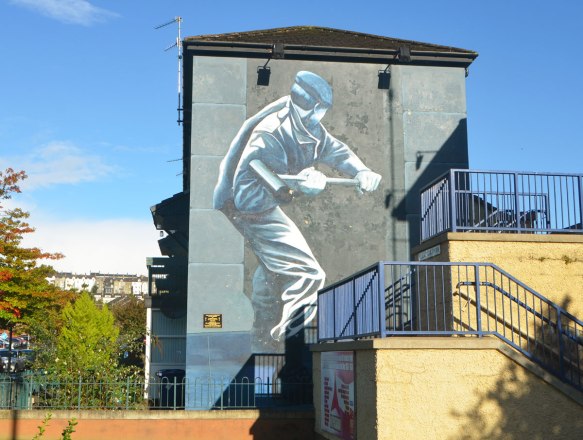
below: In the foreground, “The Runner”, a cautionary tale; civil conflict can be deadly. The boy in blue, running from tear gas, is Patrick Walsh. Below him are portraits of two other boys who died in the Troubles, Manus Deery and Charles Love. Deery was 15 when he died in 1972, hit by fragments of a ricochet bullet fired by a British Army sniper. Love was 16 when he died in 1990, hit by flying debris from an IRA (Irish Republican Army) bomb. The deaths of two boys, unintended victims of both sides in the conflict.

below: “The Death of Innocence”. A 14-year-old schoolgirl, Annette McGavigan, was killed in crossfire between the IRA and the British Army on 6 September 1971. She was the 100th victim of the Troubles. The mural was painted in 2000 but was being cleaned up and behind scaffolding when I saw it. According to the plaque beside it, “she stands against the brooding chaos of a bombed-out building, the roof beams forming a crucifix in the top right-hand corner. At the left, a downward-pointing rifle, broken in the middle, stands for the failure of violence, while the butterfly symbolizes resurrection and the hope embodied in the peace process.”

On 30 January 1972 there was a march to protest the mass arrest of 342 people suspected of being members of the IRA a few months previous, and their subsequent imprisonment without trial. The marchers were unarmed. The British Army opened fire on the people, killing 14 and wounding many others. Many of the victims were shot while fleeing from the soldiers and some were shot while trying to help the wounded. Two people were run down by Army vehicles.
below: Father Daly, a priest, holds a white flag as he helps a group of men carry the body of Jackie Duddy. Duddy was the first fatality on Bloody Sunday. This mural was painted in 1997 to commemorate the 25th anniversary of Bloody Sunday.
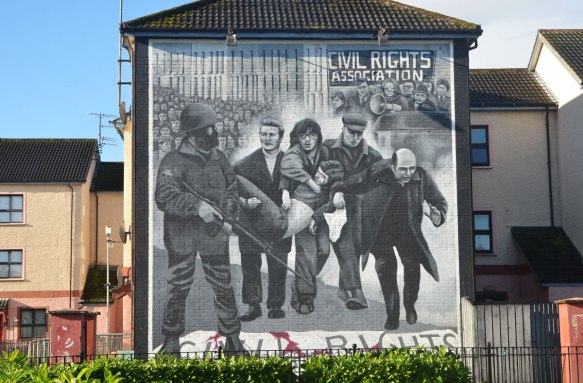


below: In the background is the Peace Mural, a white dove on a multicoloured background.
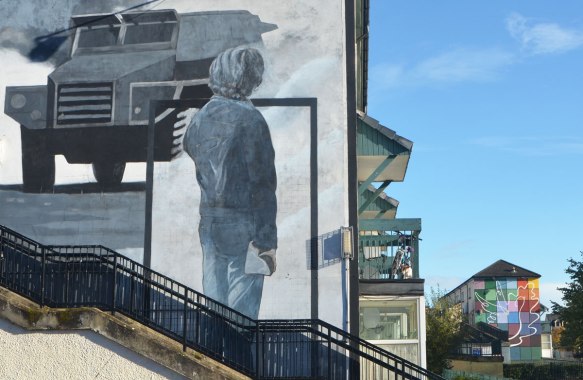
There are a number of other murals in the area.
below: Che Guevara did have a small bit of Irish ancestry. One Patrick Lynch left Galway in the mid 1700’s. After a short stay in Spain he ended up in Argentina where he married an Argentinian woman. A number of generations later, Che Guevara, eldest son of Ernesto Guevara Lynch and Celia de la Serna y Llosa, was born in Rosario Argentina in 1928. He was the 5 x great grandson of Patrick. The quote in the mural, “In my son’s veins flowed the blood of Irish Rebels” are apparently Che’s father’s words.

below: South Africa and Ireland, side by side. A portrait of Nelson Mandela. “Many suffer so that some day future generations will live in justice and peace”, a quote from Bobby Sands (also pictured in the mural). Sands was a member of the Provisional IRA and a leader of the 1981 hunger strike in Maze Prison. He was elected as a Member of Parliament but during the strike, but he died along with nine others.
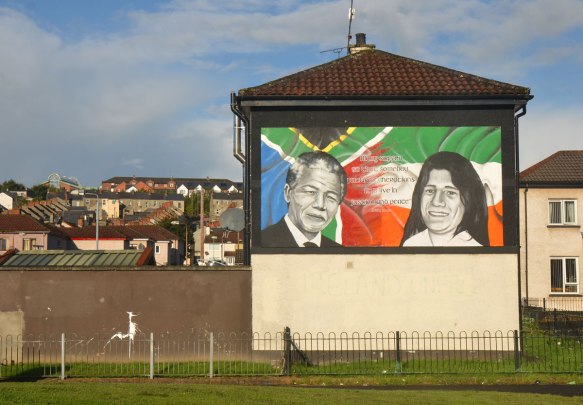
below: “The way we were” and “free Gaza”.


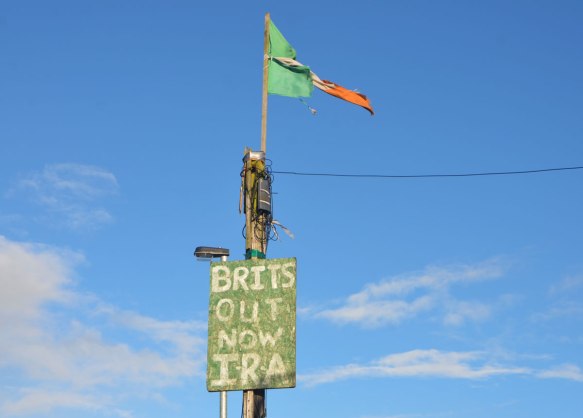
More information on the Bogside Artists and the murals that I missed.
